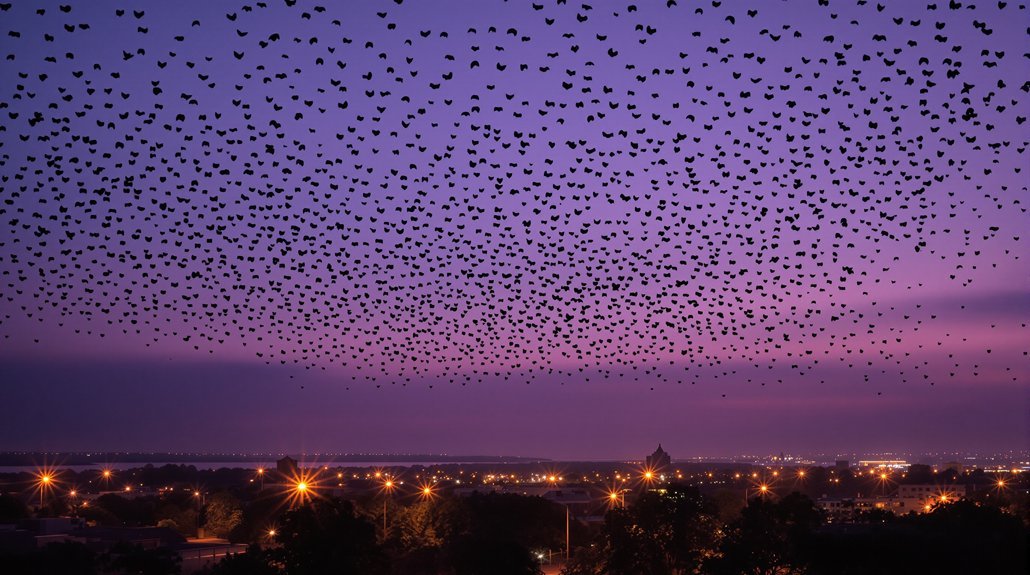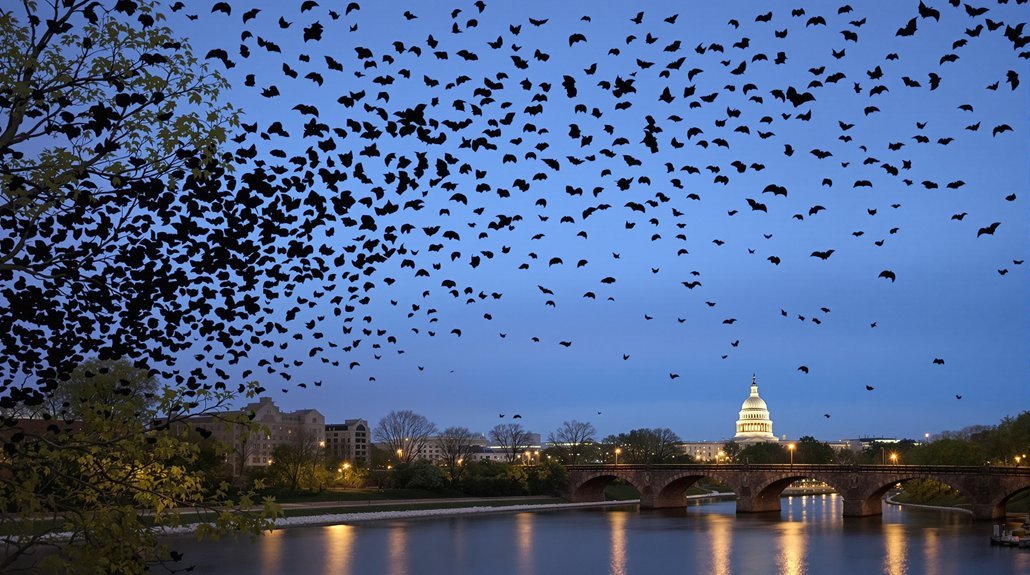Bats suddenly appear in Des Moines mainly due to seasonal migration. They travel in search of food and ideal roosting spots. These bats are often seen in urban and natural areas where they find rich insect populations. Roosting spots can be buildings, trees, or wetlands. Their appearance is a sign of changing seasons and the availability of resources. There is more to discover about bats and their role in the local ecosystem.
Key Article Highlights
- Bats may appear suddenly in Des Moines as they migrate in search of abundant food sources, particularly insects.
- Urban areas provide rich foraging opportunities, attracting bats to hunt for pests like mosquitoes and moths.
- Seasonal changes and warmer weather can prompt bats to emerge from roosts to take advantage of increased insect populations.
- Habitat alterations, such as the introduction of flowering plants, can enhance local insect availability, drawing bats into neighborhoods.
- Increased nighttime activity, such as outdoor lighting and noise, may disrupt bats’ natural behaviors, causing them to become more visible.
The Importance of Bats in the Ecosystem

Bats play a crucial role in maintaining a healthy ecosystem. They are important for controlling insect populations, as many bat species consume large quantities of insects each night. This natural pest control helps reduce the need for chemical pesticides, benefiting both humans and the environment. Additionally, bats contribute to plant pollination and seed dispersal, promoting biodiversity. Bat conservation is essential to sustain these benefits. When bat populations decline, the balance of the ecosystem is disrupted, leading to increased insect numbers and decreased plant diversity. Protecting bats ensures that they can continue to fulfill their roles in the ecosystem. Promoting bat conservation efforts helps maintain ecosystem balance, highlighting the importance of these creatures in our environment. Proper bat removal is also essential to prevent invasive colonies from causing noise, odors, and property damage. Understanding bat behavior and timing can greatly improve efforts to protect both bats and property owners.
Common Bat Species in Des Moines

In Des Moines, several common bat species can be found. The most prevalent include the little brown bat and the big brown bat. These species often inhabit bat roosts in buildings, trees, and caves. Their roosts provide safety during the day. At night, they engage in foraging behaviors to locate food. They primarily feed on insects, which they catch in the air using echolocation. This skill allows them to hunt effectively in the dark. Other species, like the Eastern red bat, also frequent the area. Each bat species plays a crucial role in controlling insect populations. Understanding these common bats helps in appreciating their contribution to the local ecosystem and the balance of nature in Des Moines.
Understanding Bat Behavior and Activity Patterns

Bats have unique behaviors and activity patterns that help them thrive. They are mostly nocturnal, feeding at night, and have specific mating and breeding seasons. Understanding their habitat preferences and migration can also explain their presence in areas like Des Moines.
Nocturnal Feeding Habits
How do these intriguing creatures navigate their nocturnal world? Bats are skilled at finding food in the dark. They primarily rely on their sharp hearing and echolocation to hunt insects during twilight hours. This time is essential for their feeding habits, as many insects are active during dusk and dawn. Bats consume a varied insect diet, which includes mosquitoes, moths, and beetles. Their ability to detect even the slightest sounds helps them capture prey efficiently. As they fly through the night sky, these creatures contribute to controlling insect populations. Understanding their nocturnal feeding habits sheds light on their important role in the ecosystem. Therefore, bats play a critical part in maintaining balance within their environment through their unique feeding behaviors.
Mating and Breeding Seasons
The mating and breeding seasons of bats are critical times in their life cycle. During these periods, male bats engage in bat courtship to attract females. This behavior often involves vocalizations and elaborate flight displays. Mating typically occurs in late summer or early fall, depending on the species. After mating, females find suitable breeding sites to give birth. These sites can include tree hollows, caves, and man-made structures. The choice of breeding site is essential for the survival of the young. Once the pups are born, mothers care for them until they are ready to fly and hunt on their own. Understanding these patterns helps in the conservation of bat populations and their habitats.
Habitat Preferences and Migration
While many factors influence where bats choose to live, habitat preferences play a significant role in their behavior and activity patterns. Bats typically select habitats that provide food, shelter, and safety. Common habitats include forests, wetlands, and urban areas with abundant insects. These preferences affect their foraging and roosting behaviors. Bat migration is another important aspect of their life cycle, as some species travel long distances to find suitable habitats during seasonal changes. During migration, bats seek areas with rich food sources and safe resting spots. Understanding habitat selection and migration patterns helps researchers protect bat populations and their ecosystems. By recognizing these behaviors, conservation efforts can be more effectively directed to support bat survival.
The Role of Echolocation in Bat Hunting
Although many creatures rely on sight to hunt, bats have developed a unique method called echolocation. This technique allows bats to emit high-frequency sounds that bounce off objects in their environment. By listening to the returning echoes, bats can determine the location, size, and shape of their prey. The echolocation accuracy of bats is remarkable, enabling them to locate insects even in complete darkness. This skill greatly enhances their hunting efficiency, allowing them to catch food quickly. Bats can adjust their calls based on the distance of their target, improving their ability to hunt successfully. Overall, echolocation is essential for bats, making them effective nocturnal predators in diverse habitats.
Human-Bat Interactions: Myths and Facts
Many people hold misconceptions about bats, often viewing them as dangerous or sinister creatures. This viewpoint is largely based on myths that ignore the facts about these animals. Myth busting is essential to change public perception. For instance, bats are not aggressive and rarely attack humans. They actually play a critical role in ecosystems by controlling insect populations and pollinating plants. Conservation efforts are fundamental to protect bat species, many of which face threats from habitat loss and disease. Educating the public can help reduce fear and promote coexistence. By understanding the true nature of bats, people can appreciate their importance and support initiatives aimed at conserving these beneficial creatures.
Tips for Coexisting With Bats in Urban Areas
Coexisting with bats in urban areas can be beneficial for both humans and wildlife. Simple practices, like creating safe habitats, using bat-friendly landscaping, and controlling noise and light, can help achieve this balance. These strategies encourage bats to thrive while minimizing conflicts with people.
Safe Habitat Practices
Creating a safe habitat for bats in urban areas can benefit both the animals and the community. Bat conservation is essential as urban development often reduces natural roosting sites. To support bats, communities can preserve trees and old buildings that provide shelter. Installing bat houses can also create safe spaces for these creatures. It is important to avoid using pesticides, as these chemicals can harm bats and their food supply. Educating the public about bats can reduce fear and promote coexistence. Local governments can work with conservation groups to develop guidelines that balance urban growth with bat protection. By implementing these practices, cities can foster a healthier environment for both bats and residents.
Bat-Friendly Landscaping Tips
Bats can thrive in urban areas with the right landscaping choices. Creating a bat-friendly environment supports bat foraging and provides shelters for bat hibernation. Simple landscaping adjustments can encourage these beneficial creatures.
- Plant native flowers and shrubs to attract insects.
- Avoid chemical pesticides that can harm bats and their food sources.
- Create a water source, like a small pond, to support foraging.
- Leave dead trees or snags as roosting spots.
- Use native plants to provide shelter and reduce harsh conditions.
These changes not only invite bats but also enhance urban biodiversity. By following these tips, residents can coexist peacefully with bats, ensuring a healthier ecosystem in their neighborhoods.
Noise and Light Control
How can urban residents minimize disturbances to bats while enjoying their outdoor spaces? One effective way is to control noise levels. Loud sounds, such as music or machinery, can interfere with bat communication and feeding habits. Residents should consider keeping noise to a minimum, especially during evening hours when bats are most active.
Additionally, reducing light pollution is essential. Bright lights can disrupt bats’ natural behavior. Installing dimmer outdoor lights or using motion sensors can help limit unnecessary brightness. Residents can also choose warmer light tones, which are less disruptive. By managing bat noise and light pollution, urban dwellers can coexist peacefully with these important creatures while still enjoying their evening activities.

